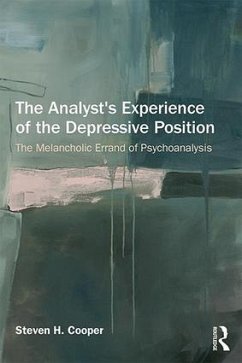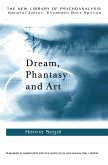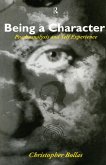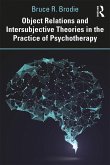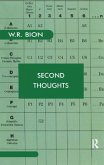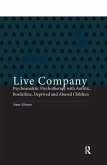Steven Cooper
The Analyst's Experience of the Depressive Position
The melancholic errand of psychoanalysis
Steven Cooper
The Analyst's Experience of the Depressive Position
The melancholic errand of psychoanalysis
- Gebundenes Buch
- Merkliste
- Auf die Merkliste
- Bewerten Bewerten
- Teilen
- Produkt teilen
- Produkterinnerung
- Produkterinnerung
The Analyst's Experience of the Depressive Position: The Melancholic Errand of Psychoanalysisexplores a subject matter previously applied more exclusively to patients, but rarely to psychoanalysts. Cooper probes the analyst's experience of the depressive position in the analytic situation.
Andere Kunden interessierten sich auch für
![Creative Readings Creative Readings]() Thomas H OgdenCreative Readings132,99 €
Thomas H OgdenCreative Readings132,99 €![Dream, Phantasy and Art Dream, Phantasy and Art]() Hanna SegalDream, Phantasy and Art140,99 €
Hanna SegalDream, Phantasy and Art140,99 €![Yesterday, Today and Tomorrow Yesterday, Today and Tomorrow]() Hanna SegalYesterday, Today and Tomorrow162,99 €
Hanna SegalYesterday, Today and Tomorrow162,99 €![Being a Character Being a Character]() Christopher BollasBeing a Character150,99 €
Christopher BollasBeing a Character150,99 €![Object Relations and Intersubjective Theories in the Practice of Psychotherapy Object Relations and Intersubjective Theories in the Practice of Psychotherapy]() Bruce BrodieObject Relations and Intersubjective Theories in the Practice of Psychotherapy159,99 €
Bruce BrodieObject Relations and Intersubjective Theories in the Practice of Psychotherapy159,99 €![Second Thoughts Second Thoughts]() Wilfred R. BionSecond Thoughts34,99 €
Wilfred R. BionSecond Thoughts34,99 €![Live Company Live Company]() Anne AlvarezLive Company140,99 €
Anne AlvarezLive Company140,99 €-
-
-
The Analyst's Experience of the Depressive Position: The Melancholic Errand of Psychoanalysisexplores a subject matter previously applied more exclusively to patients, but rarely to psychoanalysts. Cooper probes the analyst's experience of the depressive position in the analytic situation.
Produktdetails
- Produktdetails
- Verlag: Routledge
- Seitenzahl: 186
- Erscheinungstermin: 6. April 2016
- Englisch
- Abmessung: 240mm x 161mm x 15mm
- Gewicht: 449g
- ISBN-13: 9781138844100
- ISBN-10: 1138844101
- Artikelnr.: 43749672
- Herstellerkennzeichnung
- Libri GmbH
- Europaallee 1
- 36244 Bad Hersfeld
- gpsr@libri.de
- Verlag: Routledge
- Seitenzahl: 186
- Erscheinungstermin: 6. April 2016
- Englisch
- Abmessung: 240mm x 161mm x 15mm
- Gewicht: 449g
- ISBN-13: 9781138844100
- ISBN-10: 1138844101
- Artikelnr.: 43749672
- Herstellerkennzeichnung
- Libri GmbH
- Europaallee 1
- 36244 Bad Hersfeld
- gpsr@libri.de
Steven H. Cooper is a psychoanalyst and teacher well known internationally for his interest in integrating independent, Kleinian and relational thinking in his clinical work and writing. A training and supervising analyst at the Boston Psychoanalytic Society and Institute, he is also Associate Professor in Psychiatry at Harvard Medical School and Co-Chief Editor Emeritus at Psychoanalytic Dialogues.
Section I. THEORETICAL BACKGROUND
Chapter 1 Ruin and Beauty I: Some Basic Assumptions and Models of the
Analyst's
Relationship to the Depressive Position
Chapter 2 Ruin and Beauty II: The Analyst's Experience and Resistance to
Grief and
Sense of Limitation in the Analytic Process
Section II. CLINICAL PROCESS
Chapter 3 The Melancholic Errand of Psychoanalysis: Exploring the Analyst's
"Good Enough" Experiences of Repetition
Chapter 4 Exploring a Patient's Shift from Relative Silence to Verbal
Expressiveness: Observations on an Element of the Analyst's Participation
Chapter 5 The Analyst's Relationship to the Psychoanalytic Process
Chapter 6 The Things We Carry: Finding/Creating the Object
and the Analyst's Self-Reflective Participation
Chapter 7 Revisiting the Analyst as Old and New Object: The Analyst's
Failures and the Therapeutic Action of Psychoanalysis
Section III. SOME BROADER IMPLICATIONS
Chapter 8 Reflections on the Aesthetics of the Psychic Boundary Concept:
Or, Why Refer to Sexual Misconduct with Patients as Boundary Violation?
Chapter 9 The Theorist as an Unconscious Participant: Emerging and
Unintended Crossings in a Post-Pluralistic Psychoanalysis
Chapter 1 Ruin and Beauty I: Some Basic Assumptions and Models of the
Analyst's
Relationship to the Depressive Position
Chapter 2 Ruin and Beauty II: The Analyst's Experience and Resistance to
Grief and
Sense of Limitation in the Analytic Process
Section II. CLINICAL PROCESS
Chapter 3 The Melancholic Errand of Psychoanalysis: Exploring the Analyst's
"Good Enough" Experiences of Repetition
Chapter 4 Exploring a Patient's Shift from Relative Silence to Verbal
Expressiveness: Observations on an Element of the Analyst's Participation
Chapter 5 The Analyst's Relationship to the Psychoanalytic Process
Chapter 6 The Things We Carry: Finding/Creating the Object
and the Analyst's Self-Reflective Participation
Chapter 7 Revisiting the Analyst as Old and New Object: The Analyst's
Failures and the Therapeutic Action of Psychoanalysis
Section III. SOME BROADER IMPLICATIONS
Chapter 8 Reflections on the Aesthetics of the Psychic Boundary Concept:
Or, Why Refer to Sexual Misconduct with Patients as Boundary Violation?
Chapter 9 The Theorist as an Unconscious Participant: Emerging and
Unintended Crossings in a Post-Pluralistic Psychoanalysis
Section I. THEORETICAL BACKGROUND
Chapter 1 Ruin and Beauty I: Some Basic Assumptions and Models of the Analyst's
Relationship to the Depressive Position
Chapter 2 Ruin and Beauty II: The Analyst's Experience and Resistance to Grief and
Sense of Limitation in the Analytic Process
Section II. CLINICAL PROCESS
Chapter 3 The Melancholic Errand of Psychoanalysis: Exploring the Analyst's "Good Enough" Experiences of Repetition
Chapter 4 Exploring a Patient's Shift from Relative Silence to Verbal Expressiveness: Observations on an Element of the Analyst's Participation
Chapter 5 The Analyst's Relationship to the Psychoanalytic Process
Chapter 6 The Things We Carry: Finding/Creating the Object
and the Analyst's Self-Reflective Participation
Chapter 7 Revisiting the Analyst as Old and New Object: The Analyst's Failures and the Therapeutic Action of Psychoanalysis
Section III. SOME BROADER IMPLICATIONS
Chapter 8 Reflections on the Aesthetics of the Psychic Boundary Concept: Or, Why Refer to Sexual Misconduct with Patients as Boundary Violation?
Chapter 9 The Theorist as an Unconscious Participant: Emerging and Unintended Crossings in a Post-Pluralistic Psychoanalysis
Chapter 1 Ruin and Beauty I: Some Basic Assumptions and Models of the Analyst's
Relationship to the Depressive Position
Chapter 2 Ruin and Beauty II: The Analyst's Experience and Resistance to Grief and
Sense of Limitation in the Analytic Process
Section II. CLINICAL PROCESS
Chapter 3 The Melancholic Errand of Psychoanalysis: Exploring the Analyst's "Good Enough" Experiences of Repetition
Chapter 4 Exploring a Patient's Shift from Relative Silence to Verbal Expressiveness: Observations on an Element of the Analyst's Participation
Chapter 5 The Analyst's Relationship to the Psychoanalytic Process
Chapter 6 The Things We Carry: Finding/Creating the Object
and the Analyst's Self-Reflective Participation
Chapter 7 Revisiting the Analyst as Old and New Object: The Analyst's Failures and the Therapeutic Action of Psychoanalysis
Section III. SOME BROADER IMPLICATIONS
Chapter 8 Reflections on the Aesthetics of the Psychic Boundary Concept: Or, Why Refer to Sexual Misconduct with Patients as Boundary Violation?
Chapter 9 The Theorist as an Unconscious Participant: Emerging and Unintended Crossings in a Post-Pluralistic Psychoanalysis
Section I. THEORETICAL BACKGROUND
Chapter 1 Ruin and Beauty I: Some Basic Assumptions and Models of the
Analyst's
Relationship to the Depressive Position
Chapter 2 Ruin and Beauty II: The Analyst's Experience and Resistance to
Grief and
Sense of Limitation in the Analytic Process
Section II. CLINICAL PROCESS
Chapter 3 The Melancholic Errand of Psychoanalysis: Exploring the Analyst's
"Good Enough" Experiences of Repetition
Chapter 4 Exploring a Patient's Shift from Relative Silence to Verbal
Expressiveness: Observations on an Element of the Analyst's Participation
Chapter 5 The Analyst's Relationship to the Psychoanalytic Process
Chapter 6 The Things We Carry: Finding/Creating the Object
and the Analyst's Self-Reflective Participation
Chapter 7 Revisiting the Analyst as Old and New Object: The Analyst's
Failures and the Therapeutic Action of Psychoanalysis
Section III. SOME BROADER IMPLICATIONS
Chapter 8 Reflections on the Aesthetics of the Psychic Boundary Concept:
Or, Why Refer to Sexual Misconduct with Patients as Boundary Violation?
Chapter 9 The Theorist as an Unconscious Participant: Emerging and
Unintended Crossings in a Post-Pluralistic Psychoanalysis
Chapter 1 Ruin and Beauty I: Some Basic Assumptions and Models of the
Analyst's
Relationship to the Depressive Position
Chapter 2 Ruin and Beauty II: The Analyst's Experience and Resistance to
Grief and
Sense of Limitation in the Analytic Process
Section II. CLINICAL PROCESS
Chapter 3 The Melancholic Errand of Psychoanalysis: Exploring the Analyst's
"Good Enough" Experiences of Repetition
Chapter 4 Exploring a Patient's Shift from Relative Silence to Verbal
Expressiveness: Observations on an Element of the Analyst's Participation
Chapter 5 The Analyst's Relationship to the Psychoanalytic Process
Chapter 6 The Things We Carry: Finding/Creating the Object
and the Analyst's Self-Reflective Participation
Chapter 7 Revisiting the Analyst as Old and New Object: The Analyst's
Failures and the Therapeutic Action of Psychoanalysis
Section III. SOME BROADER IMPLICATIONS
Chapter 8 Reflections on the Aesthetics of the Psychic Boundary Concept:
Or, Why Refer to Sexual Misconduct with Patients as Boundary Violation?
Chapter 9 The Theorist as an Unconscious Participant: Emerging and
Unintended Crossings in a Post-Pluralistic Psychoanalysis
Section I. THEORETICAL BACKGROUND
Chapter 1 Ruin and Beauty I: Some Basic Assumptions and Models of the Analyst's
Relationship to the Depressive Position
Chapter 2 Ruin and Beauty II: The Analyst's Experience and Resistance to Grief and
Sense of Limitation in the Analytic Process
Section II. CLINICAL PROCESS
Chapter 3 The Melancholic Errand of Psychoanalysis: Exploring the Analyst's "Good Enough" Experiences of Repetition
Chapter 4 Exploring a Patient's Shift from Relative Silence to Verbal Expressiveness: Observations on an Element of the Analyst's Participation
Chapter 5 The Analyst's Relationship to the Psychoanalytic Process
Chapter 6 The Things We Carry: Finding/Creating the Object
and the Analyst's Self-Reflective Participation
Chapter 7 Revisiting the Analyst as Old and New Object: The Analyst's Failures and the Therapeutic Action of Psychoanalysis
Section III. SOME BROADER IMPLICATIONS
Chapter 8 Reflections on the Aesthetics of the Psychic Boundary Concept: Or, Why Refer to Sexual Misconduct with Patients as Boundary Violation?
Chapter 9 The Theorist as an Unconscious Participant: Emerging and Unintended Crossings in a Post-Pluralistic Psychoanalysis
Chapter 1 Ruin and Beauty I: Some Basic Assumptions and Models of the Analyst's
Relationship to the Depressive Position
Chapter 2 Ruin and Beauty II: The Analyst's Experience and Resistance to Grief and
Sense of Limitation in the Analytic Process
Section II. CLINICAL PROCESS
Chapter 3 The Melancholic Errand of Psychoanalysis: Exploring the Analyst's "Good Enough" Experiences of Repetition
Chapter 4 Exploring a Patient's Shift from Relative Silence to Verbal Expressiveness: Observations on an Element of the Analyst's Participation
Chapter 5 The Analyst's Relationship to the Psychoanalytic Process
Chapter 6 The Things We Carry: Finding/Creating the Object
and the Analyst's Self-Reflective Participation
Chapter 7 Revisiting the Analyst as Old and New Object: The Analyst's Failures and the Therapeutic Action of Psychoanalysis
Section III. SOME BROADER IMPLICATIONS
Chapter 8 Reflections on the Aesthetics of the Psychic Boundary Concept: Or, Why Refer to Sexual Misconduct with Patients as Boundary Violation?
Chapter 9 The Theorist as an Unconscious Participant: Emerging and Unintended Crossings in a Post-Pluralistic Psychoanalysis

